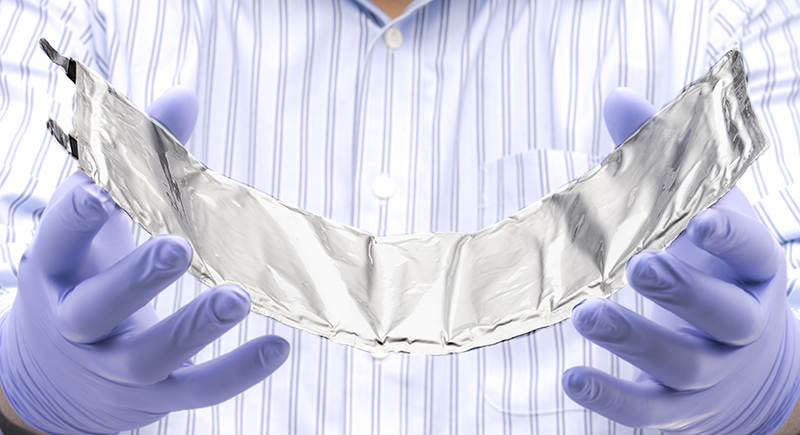Press Release
Johns Hopkins APL Research Team Tackles Electrode in Quest for Safer Batteries
A team of researchers from the Johns Hopkins Applied Physics Laboratory (APL) has developed a scalable process for producing a safe, high-energy-density battery anode — another landmark achievement in the Laboratory’s quest to create effective, durable lithium-ion batteries.
The research, which was published recently in the Journal of Materials Chemistry A, is a parallel effort to the initiative to create a powerful, flexible, incombustible electrolyte. This time, the team explored the safety of the battery’s electrode, synthesizing the material — aluminum niobate — from scratch on the Lab’s Laurel, Maryland, campus.
Relying on flammable and combustible materials, lithium-ion batteries (LIBs) can catch fire or explode, often without any discernable warning. The APL team’s approach to fixing this problem in LIBs, the ubiquitous energy storage vehicle of choice, is multipronged. One path was to create a nonflammable electrolyte; another was to improve the safety of the electrode.
“High energy commercial batteries today use a graphite anode,” explained Konstantinos Gerasopoulos, the project’s principal investigator in APL’s Research and Exploratory Development Department (REDD). “Graphite has high energy density, but that’s what makes it dangerous. It operates close to what we call lithium-plating potential, which is what leads to hazards with a flammable electrolyte.”
Imagine that you plug in your cell phone to charge its battery. If it charges too fast or for too long in uncontrolled conditions (with the wrong charger, for example), a deposit called a lithium dendrite can form on the graphite anode, growing like a tree branch. If it grows too large, Gerasopoulos explained, it can pierce through the battery’s separator into the cathode, short the battery and cause the temperature to rise. With a flammable electrolyte, enough heat will cause a fire.
Aluminum niobate (ANO) is a safer electrode than graphite, but it has lower voltage, which the team has worked to mitigate. The voltage of a battery is simple math: the voltage of the cathode (typically about 4 volts) minus the voltage of the anode. An anode such as that used in the team’s previous work, lithium titanium oxide (LTO), provides safety but produces less total voltage, while graphite has a high capacity and energy density — which is what makes it unsafe.
“ANO combines the benefits from both,” Gerasopoulos said. “It has a higher capacity, like graphite, and safe voltage, like LTO. It’s not the full capacity of graphite, but it’s much closer. Plus, it has a high material density — which means that you can get the same capacity as the other anodes using a lower volume. In practical terms, this translates to thinner electrodes, which allows for more cells to be put into one package.”
In the study, the team from REDD's Signature, Electromagnetics, and Energy Research program was also able to produce ANO using a method that could be replicated at commercial scale, and demonstrated operation in pouch cells — one of the main types of commercial batteries — with high energy.
“What is exciting about our work is we’ve shown we can synthesize the material in large amounts,” said Matt Logan, the lead author of the paper, along with Dajie Zhang and Bing Tan, also of REDD. “We can also build pouch cells with specifications that you see in industry.”
“Anywhere LTO is used today can now be displaced by ANO because it has much higher energy and power performance, and it’s just as safe,” added Jeff Maranchi, who manages the Research Program Area at APL. “This new work is a testament to our efforts at APL to address safety and performance for all components in a lithium-ion battery. I am excited about the direction of our research and development efforts. When we literally start layering innovation upon innovation, the potential for widespread, transformative impact across all facets of everyday life increases substantially.”
In partnership with the Lab’s Tech Transfer office, Maranchi is spearheading the effort to transition APL’s battery technologies to practical applications. APL hosted the Power on the Move event earlier this year, engaging power and energy industry leaders on that very topic.
“The scalable and straightforward synthetic method introduced here produced ANO in large quantities that exhibited excellent electrochemical properties, including a high gravimetric capacity,” the authors write. “Furthermore, optimization of electrode formulation allowed for high, commercially relevant loadings that were capable of maintaining a specific capacity … higher than that of commercial-grade ... [w]hen compared to graphite, ANO shows higher reactivity when fully charged and exposed to air but much lower thermal instability under direct internal short of full cells.”
The team’s findings were published in the Journal of Materials Chemistry A, a Royal Society of Chemistry publication.
